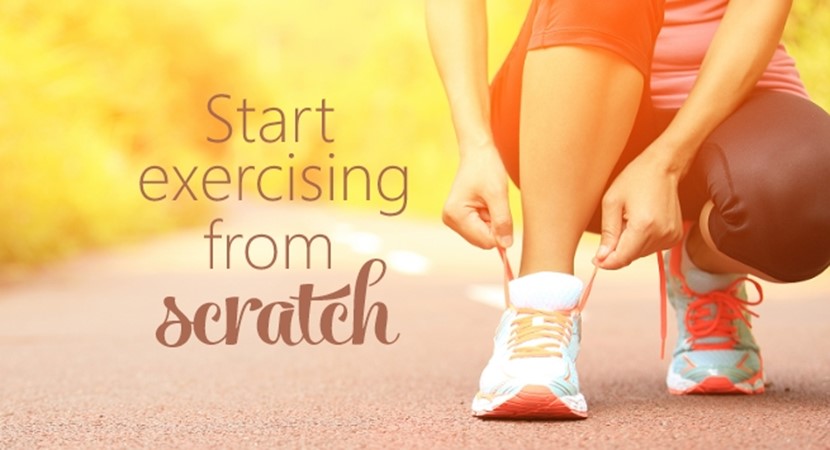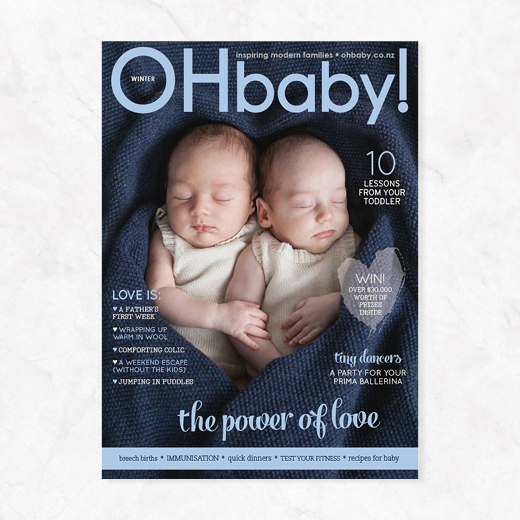Start exercising from scratch

The demands of caring for small children mean exercise is the last thing many new parents have time for. OHbaby! fitness expert Renée Vincent gets honest about deconditioning and answers the awkward question of just how fit is unfit.
Quite often I treat women who have been injured by 'overdoing it' while exercising soon after having baby. Keen to get their old body back and to feel fit and strong again, they’ve done an exercise session similar to what they were used to pre-baby and hurt themselves.
At the same time I also see women who are too scared to exercise, knowing that their body has changed so much. Starting from scratch isn't easy, but with a little knowledge you can start exercising again safely and effectively.
Deconditioning is the word we use to describe the loss of physical strength and fitness that occurs when you don’t exercise for a period of time. To be as fit and strong after baby as you were before pregnancy, you would need to exercise at a consistent level throughout your pregnancy, so it's inevitable that some deconditioning will occur. In fact, according to the American College of Sports Medicine, just two weeks of not exercising can result in a significant loss of fitness.
Moderate activity during pregnancy or postnatally, such as taking the dog for a walk or doing some gardening, will count towards your strength and fitness. However, if you previously did all of this and also exercised regularly, you would still notice some deconditioning and you'll need to build your formal exercise programme from scratch.
Time to assess
Starting from scratch in this context means building your exercise up gradually from your current fitness level. It is really important to take the time to test your fitness level before you start exercising again. This will help you set goals and let you know when you’ve made progress, but it will also give you some concrete information to guide the type and intensity of exercise you should do. If you have had any pregnancy or postnatal medical complications, or currently have any medical conditions, it is best to check with your doctor before starting an exercise programme.
There are literally dozens of fitness tests you can do, but I have chosen four that test the main components ideal for a postnatal fitness programme. They only take minutes to perform. The first is the step test which measures your cardiovascular fitness – or how puffed and tired you get while exercising. The second and third are the squat and push-up tests to test your leg, upper body, and core strength. The fourth is the sit-and- reach test for flexibility.
Mind the gap
I intentionally didn't include an abdominal strength test, even though this is one of the areas that women are most interested in working on after having a baby. The traditional core strength tests are often not safe for new mums to perform. During pregnancy the abdominals are lengthened and, in many women, the six-pack muscle – the rectus abdominis – separates in such a way that, after delivery, they are left with a large gap between the muscle heads. This is called having a rectus abdominis diastasis (RAD).
A quick self-check is to lie on your back with knees bent up, place your fingers horizontally at your belly button between the two sides of the six-pack muscle. Then lift your head off the ground and do a small curl-up while feeling to see how many fingers fit between the two sides of the muscle. If you have a gap of more than two fingers, then you may have a RAD that needs assessing by a women’s health physiotherapist before you start exercising again. You would need to avoid exercises such as curl-ups, sit-ups, full planks, double leg lifts and any rotational or twisting core exercises – in short, any high-intensity core exercises that involve straining hard with the abdomen. How long you should avoid these depends on how severe the RAD is and how quickly it returns to 2cm or less, as well as whether you have any pelvic floor problems or back issues.
To keep core evaluation safe for everyone, rather than a standardised test like the others I describe, I suggest trying out the bird-dog exercise (below). You'll be able to safely assess your own strength and start building those tummy muscles back up.

|
Bird-dog exercise for core strength |
Cardiovascular or aerobic exercise
Cardiovascular or aerobic exercise involves activities that use our larger muscle groups – activities we can do continuously and rhythmically that increase our heart rate and make us breathe harder. Examples are walking or hiking, running or jogging, cycling, water aerobics, rope-skipping, rowing, stair-climbing, swimming, and racquet or team sports. Your aim should be 150-300 minutes per week of moderate exercise (for more, read my article Find The Time To Exercise).
When you are exercising at a moderate level, you’ll find that, while you’re not able to sing, you can still talk easily. If your starting level of fitness is very low, you may have to build up to exercise at a moderate level at the recommended 150-300 minute duration. In this case, you might start by exercising only 60 minutes a week, only 15 minutes at a time, and at a low level, building up your fitness gradually and over time.
It's also important to find an exercise that fits into your lifestyle. After you've had a baby, you're best to start with low-impact exercise such as walking or cycling. Start with 15-30 minutes and, when this becomes easy, speed up your pace and increase your exercise time to up to 60 minutes. If this is going well and you have no pain in any of your joints, you can then start to incorporate some running. If you are performing more vigorous exercise like running, tennis, fast cycling, or netball, then you should be only aiming to do 75–150 minutes a week.
Always remember that you shouldn't run or do high-impact activities until you are sure that your pelvic floor muscles are working well and until your abdominals are no longer separated further than 2cm. A walk-run programme is a good way to get your heart rate up without overstressing your joints and to gradually build up your running. In a walk-run programme you alternate walking with 1–2 minutes of running, allowing your heart rate to settle a little between bouts of running. You can start by fitting five minutes of running into a 30 minute walk and then gradually increase the number of running minutes. Once you can run 15–20 minutes comfortably, you can then start to prepare for other high-impact activities such as team sports. A quick search online will reveal plenty of walk-run programmes you could follow.
With regard to weight management and cardio exercise, remember that the most important factor in weight loss or weight management is managing your nutrition. An exercise programme will support your efforts and improve your body composition (muscle versus fat), but should not be your main tool to manage your weight.
Muscle strength, endurance, and flexibility
The American Centre for Disease Control and Prevention recommends that adults do muscle-strengthening exercises for all the major muscle groups at least twice a week. Muscle-strengthening or resistance-training can be done in a gym but you can also do it at home using your body weight (eg doing push-ups, squats, lunges, and/or the bird-dog core exercise) or using resistance bands or weights. Again, there are many resources available in the form of books, DVDs, or online to provide you with a home resistance programme. Look for a programme that is aimed at your level, that explains all exercises carefully, and points out the reasons why you would not perform a particular exercise. It should be produced by a qualified personal trainer or health professional and preferably aimed at postnatal recovery.
Adults should also do flexibility exercises 2–3 times a week to improve range of motion. So, allow enough time after your cardiovascular workout to stretch. Each stretch should be firm but comfortable, held for 30 seconds, and repeated 2–4 times. Alternatively, you could use a yoga DVD or join a yoga, Pilates, or combined exercise and stretch class.
KEY POINTS IF YOU'RE STARTING FROM SCRATCH
● Be sure to take into account any medical conditions you have, and any physical problems such as a RAD, pelvic floor weakness, or joint or muscle pain.
● It is very helpful to test for fitness, strength, and flexibility before starting so you can be realistic about your new exercise programme.
● Aim to include aerobic exercise, resistance exercise, and stretching into your programme.
● Start at a very achievable and comfortable level, and increase gradually over time.
OHbaby! fitness expert, Renée Vincent, is a physiotherapist at Total Mums in Auckland and mum to an energetic pre-schooler. The fitness tests she outlines are from topendsports.com.
For more fitness tests and how to assess your level click on the below images.
 |
 |
| 3-minute step test | Squat test |

AS FEATURED IN ISSUE 30 OF OHbaby! MAGAZINE. CHECK OUT OTHER ARTICLES IN THIS ISSUE BELOW



















